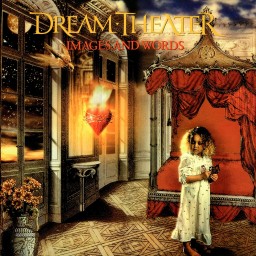 Review by Saxy S for Dream Theater - Images and Words (1992)
Review by Saxy S for Dream Theater - Images and Words (1992)
When people think of progressive metal, one of the first names that most people think of is Dream Theater. And that should come as no surprise. During the 1990s when prog metal was becoming prominent, Dream Theater were at the front of the revolution. Countless numbers of imitators have tried to copy Dream Theater's sound over the years; most of which failed. And it also doesn't help matters that Dream Theater are still around today, making very similar music as well.
I mentioned previously in my review for the bands most recent album, Distance Over Time that I have had a very difficult relationship with this group. This is lead by the fact that, being the prototypical progressive metal band, it's very difficult to find any originality from them in the modern day. Certainly a respectable band, but hardly memorable.
So going back and listening to Images and Words gives me the opportunity to see where Dream Theater began and what's changed since their humble beginnings. And not much has changed since 1992; part of the reason why my relationship with Dream Theater has been so convoluted.
That being said, I can still appreciate what this album was able to accomplish. It truly is a trend setter of the most obvious variety. And it would only set the benchmark for what would become the bands superior albums later on in the decade. This album paints its "images through words" and does a wonderful job of connecting these images from one track into the next. Whether that be the use of similar harmonic themes in the ensemble all throughout "Learning to Live" such as the opening riff from "Pull Me Under", the percussion patterns from "Metropolis - Part 1: The Miracle and the Sleeper", to outright copying the main theme from "Wait For Sleep" and using it as a coda on "Learning To Live". Or perhaps cross referencing other lyrics from previous tracks later on in the albums runtime.
The production on this album has aged like a fine wine. How the band is able to have each instrumental passage sound so crisp and precise; how each instrument is an important member of the collective whole. Even during Petrucci ridiculous solo passages, John Myung's bass lines never become swamped underneath the keyboard harmonies, or Mike Portnoy's percussion.
My least favourite part of the album comes from James LaBrie. I think he is a fantastic singer and one of the best pure vocalists in metal, period. But on this album, he sounds like he is just trying to get his feet wet. As a result, there are a couple of questionable passages where LaBrie's vocals are given a swath of pitch correction. These happen primarily during the extended highs on songs like "Take the Time" and "Learning to Live". The band would eventually iron out these issues on later records, but it was a stylistic decision made by the band at the time, so I do have to point it out.
By today's standards, Dream Theater's Images and Words is, by enlarge, an unoriginal progressive metal album that lacks any unique qualities compared to... everyone else in the genre! But for a time, it was game changing. The fact that you can still hear its influence in progressive metal today is a testament to its longevity. But what I like about this album the most is the planting of the seed. This album could have been good enough if it hadn't included "The Miracle and the Sleeper" with its long form composition and performance. But they did include it. And it formed the basis for what I consider to be Dream Theater's superior records, Scenes From A Memory and Six Degrees of Inner Turbulence. Images and Words is the lesser of the three grand Dream Theater albums, but one still worth revisiting to see where Dream Theater, and progressive metal in general, got their start.
